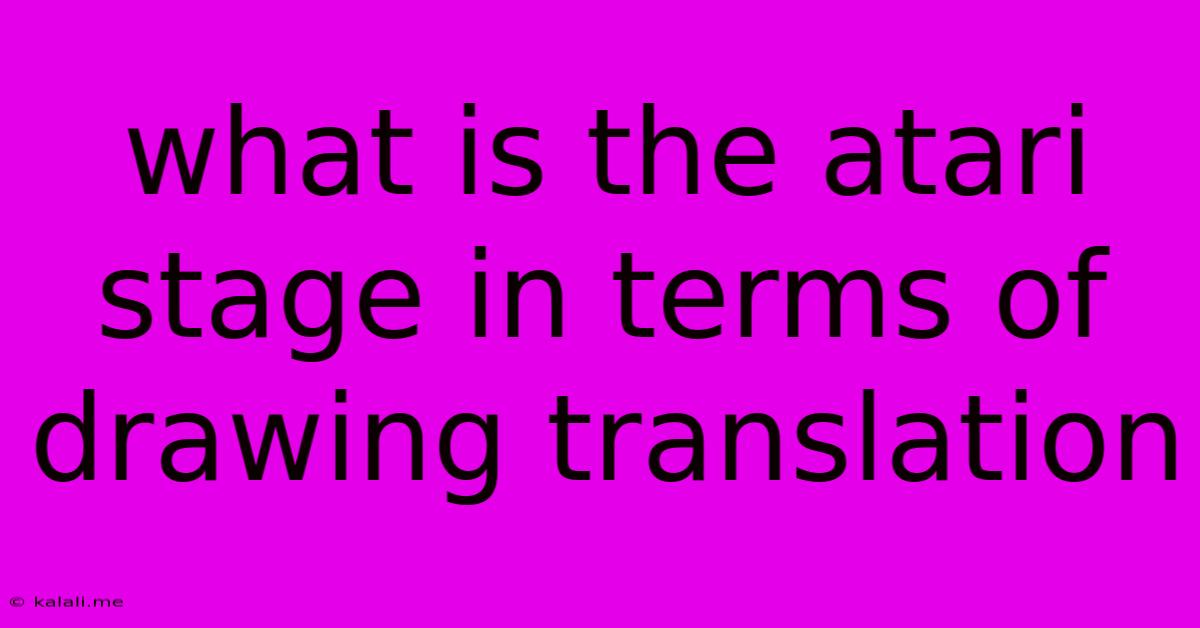What Is The Atari Stage In Terms Of Drawing Translation
Kalali
May 23, 2025 · 3 min read

Table of Contents
What is the Atari Stage in Drawing Translation? Understanding Vectorization and Rasterization
The "Atari stage" in drawing translation isn't a formally recognized term in the graphics or translation fields. However, based on the context of drawing translation and the limitations of early Atari consoles, we can infer its meaning. It likely refers to the process of converting vector graphics into a rasterized image suitable for display on low-resolution devices like early Atari systems. This conversion process involves significant challenges and compromises, impacting the final visual output.
This article delves into the implications of translating drawings for low-resolution displays, focusing on the key concepts of vector and raster graphics, the challenges of downscaling, and the visual artifacts commonly associated with this type of translation.
Understanding Vector and Raster Graphics:
Before we explore the "Atari stage," let's clarify the core difference between vector and raster graphics.
-
Vector Graphics: These are based on mathematical equations that define lines, curves, and shapes. They are scalable without loss of quality because the image is defined by its mathematical description, not pixels. Think of scalable vector graphics (SVG) files or illustrations created in Adobe Illustrator.
-
Raster Graphics: These are comprised of a grid of pixels (picture elements). Each pixel has a specific color value. Images like JPEGs and PNGs are raster graphics. Resizing raster images can lead to pixelation and loss of detail.
The Challenges of the "Atari Stage" (Downscaling Vector Graphics):
The "Atari stage" refers to the difficulties encountered when attempting to display vector graphics on the limited resolution of early Atari consoles. These consoles had extremely low resolution compared to modern screens, typically ranging from 160x200 to 320x200 pixels. Translating detailed vector drawings into this low-resolution environment requires significant simplification:
-
Loss of Detail: Fine lines and intricate details are often lost in the translation process due to the limited pixel density. The rasterization process has to approximate the curves and shapes using the available pixels.
-
Pixelation and Jagged Edges: Straight lines might appear jagged or stair-stepped ("aliased") because the pixels cannot perfectly represent the continuous lines of the vector image. Curves can appear blocky and lose their smoothness.
-
Color Limitations: Early Atari systems also had limited color palettes. The translation process might need to approximate colors using the available palette, potentially altering the visual appearance.
Techniques Used for Downscaling:
Several techniques could be employed to translate vector graphics for low-resolution displays, each with its own compromises:
-
Simple Pixel Approximation: The most basic approach is to map the vector data directly onto the pixel grid, resulting in significant loss of detail and jagged edges.
-
Anti-aliasing: While sophisticated anti-aliasing techniques were not readily available in early Atari graphics, rudimentary forms might have been employed to slightly soften jagged edges by blending pixel colors.
-
Line Simplification: Algorithms might simplify the vector lines, reducing the number of points to render, sacrificing detail for improved performance.
-
Dithering: To simulate more colors than the system's limited palette allows, dithering techniques could have been used. This involves strategically placing pixels of different colors to create an optical illusion of additional colors.
Conclusion:
While not a formal term, the "Atari stage" aptly describes the challenges of translating vector graphics to low-resolution raster displays. The process inevitably leads to a loss of detail, pixelation, and potential color inaccuracies. Understanding the limitations of early systems like the Atari consoles helps to appreciate the advancements in graphics technology and the sophisticated algorithms now used for high-quality image rendering and upscaling. This understanding is crucial for anyone working with image translation and the complexities of vector-to-raster conversion.
Latest Posts
Latest Posts
-
In Magento 2 How To Trigger Form Validation On Blur
May 23, 2025
-
Toilet Fill Valve Leaking From Top
May 23, 2025
-
Expandable Group Header Sharepoint List Gallery View
May 23, 2025
-
Why Does My Cat Follow Me To The Bathroom
May 23, 2025
-
Butter My Bottom And Call Me A Biscuit
May 23, 2025
Related Post
Thank you for visiting our website which covers about What Is The Atari Stage In Terms Of Drawing Translation . We hope the information provided has been useful to you. Feel free to contact us if you have any questions or need further assistance. See you next time and don't miss to bookmark.